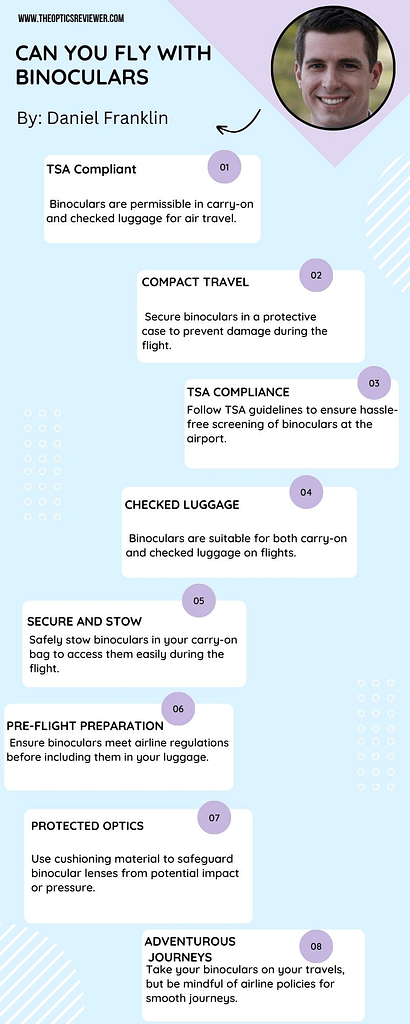Planning your next adventure and wondering, Can you fly with binoculars? Whether you’re a nature enthusiast, birdwatcher, or avid traveler, bringing your binoculars along for the journey is not only allowed but encouraged. Imagine capturing breathtaking landscapes, spotting elusive wildlife, or observing celestial wonders during your travels.
In this guide, we’ll explore the ins and outs of flying with binoculars, providing you with essential tips on packing, ensuring safety, and understanding airline regulations. So, pack your sense of wonder, and let’s embark on a journey where your binoculars become the perfect travel companion, enriching your experiences and creating lasting memories. Get ready to soar to new heights with the freedom to explore the world through your lenses. Can you fly with binoculars? Absolutely, and we’re here to guide you every step of the way!
Contents
- 1 Key Takeaways
- 2 Can You Fly With Binoculars?
- 3 Can Binoculars Be Carried in a Carry-on Bag?
- 4 Are There Any Specific Packing Requirements For Binoculars in Checked Luggage?
- 5 What are the Guidelines For Packing Binoculars in Checked Luggage?
- 6 What are the TSA Regulations For Carrying Binoculars in Checked Luggage?
- 7 Conclusion
- 8 References
- 9 Frequently Asked Questions
- 9.1 Can Binoculars Be Used During the Flight?
- 9.2 Are There Any Restrictions on the Size or Weight of Binoculars for Carry-On Baggage?
- 9.3 Are There Any Special Precautions to Take When Packing Binoculars in Checked Luggage to Prevent Damage?
- 9.4 Can Binoculars Be Taken Out of Their Case During Security Screening?
- 9.5 Are There Any Restrictions on Bringing Multiple Pairs of Binoculars on a Flight?
Key Takeaways
- Binoculars can be carried in a carry-on bag with compact, lightweight models.
- Protect binoculars in sturdy cases, following airline guidelines for smooth travel.
- Remove accessories and secure binoculars in cushioned cases for checked luggage.
- Confirm TSA size limitations and label luggage for fragile items like binoculars.
Can You Fly With Binoculars?
When traveling by air, carrying binoculars is permissible, subject to adherence to airline regulations and security procedures. Binoculars on airplanes are generally allowed in carry-on luggage. However, it is essential to verify specific airline policies regarding the size and weight limitations for items brought into the cabin.
Flying with binoculars requires passengers to ensure that the binoculars are securely packed to prevent damage during the flight. Additionally, travelers should be prepared to remove the binoculars from their bag during the security screening process. Binoculars in cabins must not obstruct the safety and comfort of other passengers or impede access to emergency exits.
Traveling with binoculars can enhance the flying experience for enthusiasts who enjoy observing landscapes from above. Carrying binoculars onboard enables passengers to enjoy scenic views from the aircraft’s window with enhanced clarity. Before boarding, it is advisable to confirm that the airline permits the transportation of binoculars in the cabin to avoid any inconvenience during the journey.

Can Binoculars Be Carried in a Carry-on Bag?
Binoculars can typically be carried in a carry-on bag when traveling by air, subject to specific airline regulations and security protocols. When considering the size and weight of binoculars, it is essential to choose a compact and lightweight model for ease of travel. Many reputable brands offer compact binoculars that are designed for portability without compromising on optical performance. These binoculars are often accompanied by accessories such as carrying cases, neck straps, lens covers, and cleaning cloths to enhance convenience and protection during travel.
Prices of binoculars can vary significantly based on the brand, features, and quality of optics. Entry-level binoculars from well-known brands can start at around $50, while premium models with advanced features can cost several hundred dollars. It is advisable to invest in a quality pair of binoculars that suit your travel needs and budget.
When packing binoculars in a carry-on bag, ensure they are well-protected to prevent damage during transit. Following airline guidelines and security measures will help ensure a smooth travel experience with your binoculars readily accessible for your adventures.
If interested you can read more about are binoculars allowed at concerts.

Are There Any Specific Packing Requirements For Binoculars in Checked Luggage?
For travelers opting to stow binoculars in checked luggage, it is imperative to adhere to specific packing requirements to ensure the safe transportation of these optical devices. When preparing binoculars for checked luggage, consider the following:
- Binoculars accessories: Remove any additional accessories like lens caps, straps, or tripod mounts and pack them separately to prevent damage.
- Travel restrictions: Familiarize yourself with airline regulations regarding the transportation of optical equipment to avoid any issues during security checks.
- Packing tips: Secure the binoculars in a sturdy, cushioned case to shield them from potential impacts during handling.
- Protective cases: Invest in a durable and well-padded case specifically designed for binoculars to provide optimal protection.
- Optical equipment: Handle the binoculars with care to prevent misalignment of the lenses or any other internal damage that could affect their performance.
What are the Guidelines For Packing Binoculars in Checked Luggage?
To ensure the secure and intact transport of optical equipment in checked luggage, meticulous adherence to specific packing guidelines is essential. When packing binoculars in checked luggage, it is crucial to provide adequate protection to prevent damage during transit. For binoculars in backpacks, ensure they are securely padded to avoid any impact or pressure that could potentially misalign the lenses.
Binoculars in briefcases should be cushioned with soft materials to absorb shock and vibrations. When placing binoculars in purses, duffel bags, or messenger bags, wrap them in soft clothing or use protective cases to shield them from potential jostling or shifting inside the luggage.
It is recommended to position the binoculars in a central location within the luggage to minimize movement. Additionally, consider utilizing any empty spaces within the bag to add extra layers of protection, such as clothing or towels, around the binoculars. By following these packing guidelines, travelers can enhance the safety of their binoculars during air travel.
If interested you can read more about when were binoculars invented.
What are the TSA Regulations For Carrying Binoculars in Checked Luggage?
Passengers transporting binoculars in checked luggage must adhere to the regulations set forth by the Transportation Security Administration (TSA). When carrying binoculars in your checked luggage, it’s essential to consider the following TSA regulations:
- Lens protection: Ensure that the lenses of your binoculars are adequately protected to prevent any damage during handling.
- Size restrictions: Check that your binoculars meet the size limitations imposed by the TSA for items in checked luggage.
- TSA approval: Confirm that your chosen binoculars are approved for air travel by the TSA to avoid any issues during security checks.
- Security screening: Be prepared for your bag to undergo additional screening due to the presence of fragile items like binoculars.
- Fragile items: Clearly label your luggage as containing fragile items, such as binoculars, to alert baggage handlers and ensure proper care is taken.
If interested you can read more about who invented the binoculars.
Conclusion
In conclusion, the answer to the question Can you fly with binoculars? is a resounding yes! As you embark on your journeys, rest assured that binoculars are travel companions allowed on flights. Enhance your experiences and capture breathtaking moments with the freedom to bring your optics along.
Whether it’s for birdwatching, sightseeing, or stargazing, flying with binoculars adds a new dimension to your travel adventures. So, pack your binoculars securely, embark on your next journey, and enjoy the world through enhanced vision, making every trip a visual delight.
References
- https://link.springer.com/article/10.1007/BF00230199
- https://www.sciencedirect.com/science/article/pii/004269899090148E
- https://www.jstor.org/stable/1419206
- https://core.ac.uk/download/pdf/212800020.pdf
Frequently Asked Questions
Can Binoculars Be Used During the Flight?
Binoculars on a plane can be used for in-flight viewing, enhancing travel experiences. When using binoculars, be mindful of cabin restrictions and respect fellow passengers. Airplane binoculars are useful for observing landscapes and landmarks during travel.
Are There Any Restrictions on the Size or Weight of Binoculars for Carry-On Baggage?
When considering binoculars in cabin baggage, it’s important to be aware of weight limits and size regulations set by airlines. To comply with TSA rules, travelers should securely store binoculars to prevent damage during travel.
Are There Any Special Precautions to Take When Packing Binoculars in Checked Luggage to Prevent Damage?
When it comes to packing binoculars in checked luggage, proper handling is crucial. To prevent damage, consider using a sturdy case, securing delicate parts, and packing accessories separately. Regular cleaning, maintenance, and safe storage also play key roles in preserving binocular quality.
Can Binoculars Be Taken Out of Their Case During Security Screening?
When passing through airport security, it is generally advised to leave binoculars in their case to facilitate screening and ensure their protection. However, it is best to consult with specific airline regulations and security guidelines for accurate information.
Are There Any Restrictions on Bringing Multiple Pairs of Binoculars on a Flight?
When considering multiple pairs of binoculars for a flight, it is essential to evaluate factors such as binocular magnification, various brands and models, necessary accessories, maintenance requirements, and intended uses. Understanding these aspects ensures informed and efficient travel planning.

